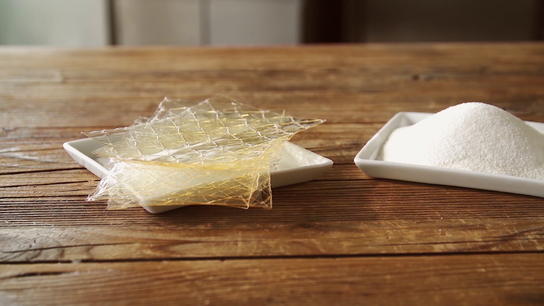Product quality of the highest standard
Gelatin is a pure collagenous protein that is obtained from animal raw materials such as pork, bovine, poultry or fish materials. The high-quality standards for gelatin are ensured through the choice of raw materials and the production process.
Premium raw materials
Gelatin production is based on a careful selection of raw materials to ensure that safety and quality standards are met. Gelatin manufacturers worldwide use only raw materials from healthy pigs, cattle, poultry and fish. Furthermore, all GROW member manufacturers produce accordingly to ISO and/or other high-level food safety and GMP standards.
Approximately 40 per cent of the edible gelatin produced worldwide is made from pork skins. 30 per cent is made from split. Split is a thin, collagen-containing layer of the cattle hide that lies between the epidermis and subcutaneous layer. The remaining 30 per cent of gelatin is made from connective tissues of cattle, pigs, chicken and fish.
Only raw materials that have been approved for human consumption are used to manufacture gelatin. In other words, the meat the consumer buys comes from the same healthy animal as the raw material used to make gelatin. Around the world, wherever gelatin is produced, it is made sure that all local safety regulations are being followed and often even exceeded.
High-tech production process
At GROW member plants, gelatin is produced in a complex, multi-stage process using high-tech industrial equipment. The starting material is the connective tissue of pigs, cattle, poultry or fish. Collagenous protein is separated from pig, calf and cattle skin and bones and made into gelatin. The final product, gelatin, is a pure, high-grade protein.
The raw materials are first freed of fat and minerals. Then two different pre-treatment methods are used, depending upon the raw material and the intended application.
Alkaline process
Bovine connective tissue is densely interconnected and is therefore pre-treated with an alkaline solution for several weeks. This gently changes the collagen structure. Following this treatment, the collagen is soluble in warm water and can thus be separated from the remaining raw material.
Acid process
Collagenous porcine connective tissue is not as densely interconnected. Collagen extraction is already possible after one-day acid treatment followed by neutralization and a thorough rinsing out of the salts.
The pre-treated raw materials are now mixed with hot drinking water and extracted in a multi-stage process. The temperature of the heated water is a parameter for gel strength: the lower the temperature of the water, the higher the gel strength, or Bloom value, of the extracted gelatin.
The extracted solutions are freed of traces of fat and fine fibers in high-performance separators. Just as in the beverage industry, the finest particles are removed through filtration. In a last purification step, the gelatin is freed of calcium, sodium, residual acid and other salts.
The gelatin solution is now concentrated in a vacuum evaporation system and thickened into a honey-like mass.
The highly concentrated gelatin solutions are sterilized, cooled, set and dried under strict hygienic conditions. This process results in “jelly noodles” that are ground into grains after drying.
The quality and purity of the gelatin is ensured through extensive quality controls in the laboratory. All of these steps are indispensable in gelatin production and have been used for decades to manufacture high-grade gelatin.

